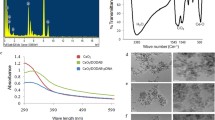Abstract
Purpose. Dequalinium, a drug known for over 30 years, is a dicationic amphiphile compound resembling bolaform electrolytes. The purpose of our work was to determine the state of aggregation of dequalinium in aqueous medium and to investigate both, its ability to bind DNA and its potential to serve as a novel non-viral transfection vector.
Methods. The form of aggregation was determined employing electron microscopic techniques. The DNA binding capacity of dequalinium was assayed using SYBR™ Green I stain. For in vitro cell transfection experiments plasmid DNA encoding for firefly luciferase was used.
Results. Dequalinium forms in aqueous medium liposome-like aggregates, which we term DQAsomes. These dequalinium vesicles bind DNA and they are able to transfect cells in vitro with an efficiency comparable to Lipofectin™.
Conclusions. Based on the intrinsic properties of dequalinium such as the in vivo selectivity for carcinoma cells and selective accumulation in mitochondria we propose DQAsomes as a novel and unique drug and gene delivery system.
Similar content being viewed by others
REFERENCES
M. Babbs, H. O. J. Collier, W. C. Austin, M. D. Potter and E. P. Taylor. J. Pharm. Pharmacol. 8:110–119 (1955).
P. M. Dunn. Eur. J. Pharmacology 252:189–194 (1994).
S. Zhuo and W. S. Allison. Biochem. Biophys. Res. Commun. 152:968–972 (1988).
W. L. Bodden, S. T. Palayoor, and W. N. Hait. Biochem. Biophys. Res. Commun. 135:574–582 (1986).
S. A. Rotenberg, S. Smiley, M. Ueffing, R. S. Krauss, L. B. Chen, and I. B. Weinstein. Cancer Res. 50:677–685 (1990).
M. J. Weiss, J. R. Wong, C. S. Ha, R. Bledlay, R. R. Salem, G. D. Steele, and L. B. Chen. Proc. Natl. Acad. Sci. USA 84:5444–5448 (1987).
E. J. Christman, D. S. Miller, P. Coward, L. H. Smith, and N. H. Teng. Gynecol. Oncol. 39:72–79 (1990).
C. Helige, J. Smolle, G. Zellnig, R. Fink-Puches, H. Kerl, and H. A. Tritthart. Eur. J. Cancer 29A:124–128 (1992).
J. D. Steichen, M. J. Weiss, D. R. Elmaleh, and R. L. Martuza. J. Neurosurg. 74:116–122 (1991).
A. E. Vercesi, C. F. Bernardes, M. E. Hoffman, F. R. Gadelha, and R. Docampo. J. Biol. Chem. 266:14431–14434 (1991).
D. Attwood and R. Natarjan. J. Pharm. Pharmacol. 32:460–462 (1979).
D. J. A. Crommelin and H. Schreier. Liposomes. In J. Kreuter (ed.), Colloidal Drug Delivery Systems, Marcel Dekker, Inc., New York, Basel, Hong Kong, 1994, pp. 73–190.
Author information
Authors and Affiliations
Rights and permissions
About this article
Cite this article
Weissig, V., Lasch, J., Erdos, G. et al. DQAsomes: A Novel Potential Drug and Gene Delivery System Made from Dequalinium™. Pharm Res 15, 334–337 (1998). https://doi.org/10.1023/A:1011991307631
Issue Date:
DOI: https://doi.org/10.1023/A:1011991307631




